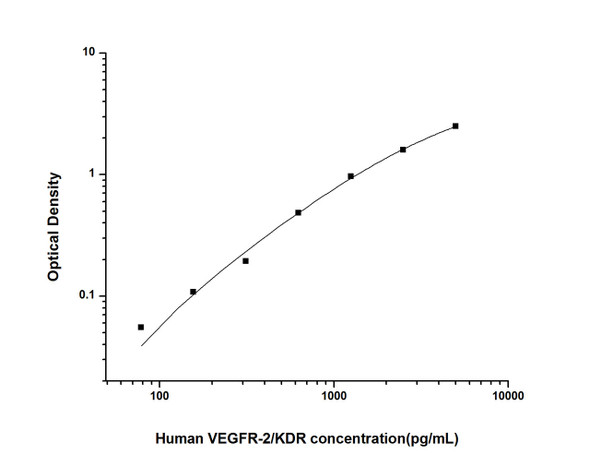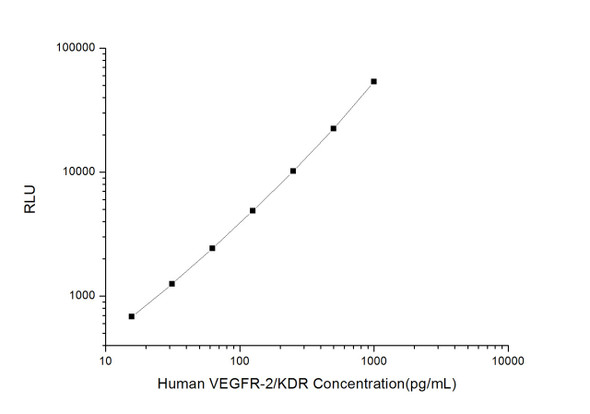Description
Rat VEGFR-2/KDR (Vascular Endothelial Growth Factor Receptor 2) ELISA Kit
The Rat VEGFR-2/KDR (Vascular Endothelial Growth Factor Receptor 2) ELISA Kit is meticulously designed to quantify the levels of VEGFR-2, a critical receptor involved in vascular endothelial growth factor (VEGF) signaling pathways, in various rat biological samples. VEGFR-2 is a fundamental player in angiogenesis, vasculogenesis, and vascular permeability and is instrumental in regulating processes related to vascular development and homeostasis. This ELISA kit enables researchers to accurately measure VEGFR-2 levels, shedding light on the intricate processes of angiogenesis and vascular function. By understanding VEGFR-2 expression and activation, researchers can delineate its role in normal physiological processes as well as pathological conditions such as cancer, cardiovascular diseases, and vascular disorders, enhancing research insights into therapeutic interventions targeting VEGF signaling.
The Rat VEGFR-2/KDR ELISA Kit offers exceptional sensitivity and specificity, ensuring precise and reproducible results. Manufactured under stringent quality control standards, this kit provides robust performance, delivering reliable data crucial for investigating the intricate roles of VEGFR-2 in vascular biology. With its user-friendly design, this ELISA kit is an excellent choice for researchers seeking to delve deeper into the complexities of VEGF signaling and vascular health in rat models.
| Product Name: | Rat VEGFR-2/KDR (Vascular Endothelial Growth Factor Receptor 2) ELISA Kit |
| Product Code: | AEES00559 |
| Assay Type: | Sandwich |
| Format: | 96T |
| Assay Time: | 3.5h |
| Reactivity: | Rat |
| Detection Range: | 3.13-200 pg/mL |
| Sensitivity: | 1.88 pg/mL |
| Sample Type & Sample Volume: | Serum, plasma and other biological fluids, 100μL |
| Specificity: | This kit recognizes Rat VEGFR-2/KDR in samples. No significant cross-reactivity or interference between Rat VEGFR-2/KDR and analogues was observed. |
| Reproducibility: | Both intra-CV and inter-CV are < 10%. |
| Application: | This ELISA kit applies to the in vitro quantitative determination of Rat VEGFR-2/KDR concentrations in serum, plasma and other biological fluids. |
This ELISA kit uses the Sandwich-ELISA principle. The micro ELISA plate provided in this kit has been pre-coated with an antibody specific to Rat VEGFR-2/KDR. Standards or samples are added to the micro ELISA plate wells and combined with the specific antibody. Then a biotinylated detection antibody specific for Rat VEGFR-2/KDR and Avidin-Horseradish Peroxidase (HRP) conjugate are added successively to each micro plate well and incubated. Free components are washed away. The substrate solution is added to each well. Only those wells that contain Rat VEGFR-2/KDR, biotinylated detection antibody and Avidin-HRP conjugate will appear blue in color. The enzyme-substrate reaction is terminated by the addition of stop solution and the color turns yellow. The optical density (OD) is measured spectrophotometrically at a wavelength of 450 nm ± 2 nm. The OD value is proportional to the concentration of Rat VEGFR-2/KDR. You can calculate the concentration of Rat VEGFR-2/KDR in the samples by comparing the OD of the samples to the standard curve.
| Kit Components: | An unopened kit can be stored at 2-8℃ for 1 month. If the kit is not supposed to be used within 1 month, store the components separately according to the following conditions once the kit is received.
|
| 1. | Add 100μL standard or sample to the wells. Incubate for 90 min at 37°C |
| 2. | Discard the liquid, immediately add 100μL Biotinylated Detection Ab working solution to each well. Incubate for 60 min at 37°C |
| 3. | Aspirate and wash the plate for 3 times |
| 4. | Add 100μL HRP conjugate working solution. Incubate for 30 min at 37°C. Aspirate and wash the plate for 5 times |
| 5. | Add 90μL Substrate Reagent. Incubate for 15 min at 37°C |
| 6. | Add 50μL Stop Solution |
| 7. | Read the plate at 450nm immediately. Calculation of the results |






